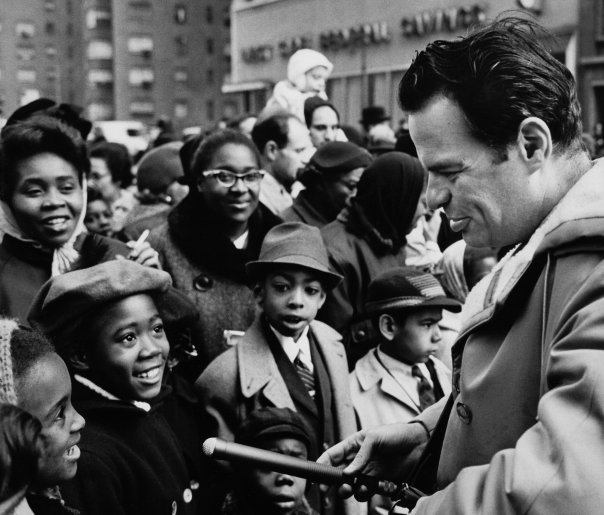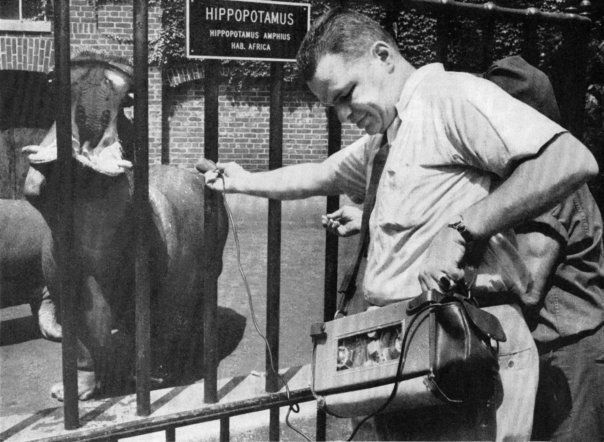On a Monday in late February 1964, a pet turtle named Tony died. It belonged to eight-year-old Darryl Cherney, who put it in a box and walked with his sister and mother from their house on New York City’s West 57th Street around the corner to Tony Schwartz’s brownstone on West 56th. Along with a box for the dead turtle, Darryl brought an American flag, a plastic clarinet, and a piece of wood. Schwartz had agreed to hold a funeral for the turtle in his backyard.
Tony Schwartz was an ad man and urban folklorist. He compiled an audio archive of sounds from the streets around his house in Hell’s Kitchen, Manhattan. He recorded almost everything that interested him, and he nearly always toted a tape recorder. For convenience, he had his commercial reel-to-reel modified—attached a shoulder strap, added a portable power source, adjusted the levels meter—so that he could carry it with him.
When Darryl arrived with the dead turtle, Schwartz pressed record.
“Can you tell me what happened?” Schwartz asked Darryl.
“He got a soft shell, and we tried to save him by giving him hamburger and things. But he died,” Darryl replied.
“How do you feel about it?”
“Not too well. It’s sort of a tragedy for me.”
Schwartz wondered about the flag and clarinet. “Why do you have the flag, and what kind of music are you going to play?”
“I’m going to play ‘Taps,’ and the flag is because I like him. It’s sort of just like the president of the United States when he died, but he’s like in my family.”
They go into the backyard with a spade. Darryl starts digging, says bye to the turtle, audibly kisses it, buries the box wrapped in the flag, and hammers down the piece of wood as a tombstone. Schwartz asks him to read what’s written on the wood.
“Here lies Tony Cherney, once a pet turtle of Darryl Cherney, died February 24, 1964.”
Darryl then plays “Taps” on the clarinet before concluding by saying, as if in disbelief at the loss of his pet: “Wow. The end.”

Schwartz believed that a tape recorder could, and should, be used like a camera: to capture snapshots of everyday life. He foresaw that, as recording devices became cheaper, people would create audio scrapbooks of their memories, in the same way they compiled photo albums. He also thought that an audiotape had an advantage over a photograph: You could ask someone how he or she felt. It gave you access to his or her inner life.
“Death of a Turtle” creates an intimacy of scale—a small child, a tiny dead turtle, toy musical instruments, and an improvised wooden tombstone—that allows age-old questions of mortality and loss to creep up on you in a disarming way. It also gestures from the specific to the global: Darryl wraps the flag around the coffin and plays “Taps” at the burial, because that’s what happened at President John F. Kennedy’s funeral a couple of months earlier. It feels at once like a miniature act of mourning for a pet and a president. Schwartz had an uncanny ability to connect the intimacy of everyday life with the troubling abstractions of the wider world.
* * *
Tony Schwartz was born in New York City on August 19, 1923. His family subsequently moved near Peekskill, New York, but he returned to Manhattan to study at the Pratt Institute. After a spell in the Navy during World War II, he began his advertising career as an art director. Around that time, he bought his first tape recorder.
When he was 16, Schwartz suffered through a six-month period of blindness after an illness. As a result, he experienced an increased sensitivity to the power of sound. “I have no interest in sound effects,” he wrote in The Responsive Chord (1973). “I am solely interested in the effect of sound on people.” He believed that sound had a potency that images couldn’t match. “We can shut our eyes, because we have eyelids,” he wrote in Media: The Second God (1981). “But we cannot shut our ears because we have no ear lids.” Schwartz’s son, Anton, recalled that his father, who died at the age of 84 in 2008, “loved to coin words and make plays on words” in this way—such as presearch: research carried out before making a commercial.
* * *
Listen to the Spotify playlist of Tony Schwartz audio clips referenced in this piece.
“Death of a Turtle” was first broadcast on Schwartz’s weekly WNYC radio program, which ran for more than 30 years between the 1945 and 1976. The show attracted the interest of the Sears-Roebuck heir William Rosenwald, who provided financial support for Schwartz to spend a year recording the sounds and music of New York City. This material was issued in a series of records for Folkways and Columbia in the 1950s. One record consisted of children’s songs, another looked at the life of a dog. There was an LP consisting solely of opinions and anecdotes solicited from New York taxi drivers, and one that recorded the experience of Puerto Rican immigrants in the city. He made a record that concentrated solely on sounds captured within his postal code, New York 19. (“Death of a Turtle” later appeared on an LP titled The Sound of Children.)
The small scale of these recordings was a reflection of the scale at which Schwartz experienced the world. Agoraphobic, he rarely ventured more than a few blocks from his house. (Although he could travel further in the company of his wife, Reenah. “With my wife, I go anywhere in Manhattan,” he told the New York Daily News in 1999.) But this didn’t limit the scale of his ambition: Curious about places he’d never visit, he swapped recordings by post with people from around the globe—a Norwegian student, a housewife in Ireland—and edited the tapes he received into a record, The World in My Mail Box.
Listening to the New York records now is like accessing another world: the rhythms and cadences of people’s speech and the background noises of the city are rendered exotic by the passage of time. “There is music in everyday speech, and often a kind of poetry in the way people talk,” Schwartz says in the introduction to a track on Millions of Musicians (1954). On The New York Taxi Driver (1959), one cabbie tells Schwartz, “A lot of people look down upon you, but those people are wrong when they look down upon you because you’re a cab driver. That is my opinion, and it’s very true.” On New York 19 (1954), Schwartz records the knotty patter of a pen salesman hawking his wares on a street corner: “Now, if you understand, realize, and appreciate a real good value, and if my physiognomy is not too conspicuous to be comprehended, I’m going to clarify to such an extent that each and every individual, standing here at the present time, can very well afford it.” This is a sentence of such idiosyncrasy and musicality that I wouldn’t have believed someone had actually spoken it had I not heard Schwartz’s recording.
* * *
From the late 1950s onward, Schwartz’s talent for communication was channeled into a highly lucrative career in advertising. His best-known ad is “Daisy,” a television spot for Lyndon B. Johnson’s presidential campaign that was shown just once, on September 7, 1964, during NBC’s Monday Night at the Movies. Although made with a team from the advertising firm of Doyle Dane Bernbach, the ad bears all the hallmarks of Schwartz: A little girl stands in a field and plucks petals from a daisy, counting up irregularly as she does so: “One, two, three, four, five, seven, six, six, eight, nine, nine.”
She looks to the sky, the film freezes, and the camera zooms in toward her right eye, as a stern, metallic-sounding nuclear countdown begins. At “zero,” the shot of the girl’s eye cuts quickly to footage of a nuclear explosion. Over the footage, the voice of Johnson says: “These are the stakes: to make a world in which all of God’s children can live, or to go into the dark. We must either love each other, or we must die.” Against the backdrop of a black screen that reads “Vote for President Johnson on November 3,” another voice urged the television audience to vote for LBJ: “The stakes are too high for you to stay home.”
The ad became a sensation and was covered on the TV news the following night, ensuring that it was reshown without Johnson’s campaign having to pay for a slot. “Daisy” targeted Barry Goldwater, the Republican nominee, implying that he was trigger-happy. Schwartz later wrote, “The commercial evoked a deep feeling in many people that Goldwater might actually use nuclear weapons. This mistrust was not in the ‘Daisy’ spot. It was in the people who viewed the commercial.” Goldwater, for his part, dismissed it as “weird television advertising.” The perceived success of “Daisy”—Johnson was elected by a landslide—ensured that Schwartz’s skills continued to be in demand, and he made thousands of spots for political campaigns, including Jimmy Carter’s presidential run in 1976 and Bill Clinton’s gubernatorial election in 1978.
* * *
Over the years, Schwartz made commercials for numerous clients, including AT&T, Betty Crocker, and Polaroid, and sometimes connections between his ads and field recordings jump out at you unexpectedly. In a Coca-Cola ad, consisting of a still image of two Coke bottles set to the sounds of festive music, of laughter, and of the beverage being poured, a woman’s voice says: “That’s my opinion, and it’s very true.”—a sentence identical to that spoken by the cabbie on The New York Taxi Driver.
Another commercial, a radio spot for American Airlines, combined Schwartz’s worlds in a mind-bending way. Schwartz had encountered a blind musician known as Moondog on the street. Moondog had long hair and a beard. He wore long flowing robes and sandals and cut an unmistakable figure. One foggy night at around 3 a.m., Moondog called Schwartz at home to say: “Dig those crazy horns!” Schwartz listened and heard the groan of foghorns across Manhattan. He invited Moondog to bring his instruments over to the house. (Moondog played a variety of musical instruments, all of his own design.) Schwartz placed a microphone on the roof of his building and fed it to a speaker in his living room, so that the blind musician could play along with the foghorns. The resulting track, recorded in a Manhattan house in the middle of the night, was used to represent the sound of San Francisco—and is what Schwartz called a “constructed reality.” The track also appeared on the album Moondog on the Streets of New York and on Schwartz’s New York 19.
* * *
Schwartz was notable for his use of the voices of real children, rather than adult actors, to play children in ads. Most of the child actors he used were from his neighborhood, and one of them was Darryl Cherney, the little boy who buried his turtle in Schwartz’s backyard in February 1964. When Schwartz spotted five-year-old Darryl riding his tricycle, he asked his mother if he could do some sound takes. Cherney did ads for Quaker Oats, Ivory Snow, and Equitable Life Insurance, among many others. The work paid well: In an interview given in 2005, Cherney estimated that he had made $35,000 by the time he was 11.
When you hear a recording as memorable as “Death of a Turtle,” you wonder: What happened to that kid? I called Cherney to find out and recognized his voice immediately.
I asked him about Tony the Turtle. He was Cherney’s first pet. Before that, Cherney had been scared of animals—he couldn’t do a dog food commercial because he was frightened of dogs. He owned the turtle for only a few months before its death. “I had not lost in my life a single being. This was my first experience with death—of somebody I knew or something that I knew.”
In the sleeve notes to The Sound of Children, Schwartz wrote that a tape recorder could be used to record audio snapshots that would help create “family albums of sound that will be treasured for generations.” Cherney took this advice to heart: He got a reel-to-reel tape recorder when he was five, and a cassette recorder “when they first came out, in 1966.” He recorded his everyday life, the voices of his parents and sister, and he still possesses those recordings.
Weekly Digest
Cherney recalled a trip across America that his family had taken, along with two Siamese cats, in 1970. He was 14. As they traveled, he recorded on tape a sort of audio diary of the experience. That was the first time he had ever seen the giant redwood trees of Northern California, and, when he first set eyes on them, he made sure the tape machine was running.
Listen to the Spotify playlist of Tony Schwartz audio clips referenced in this piece.







